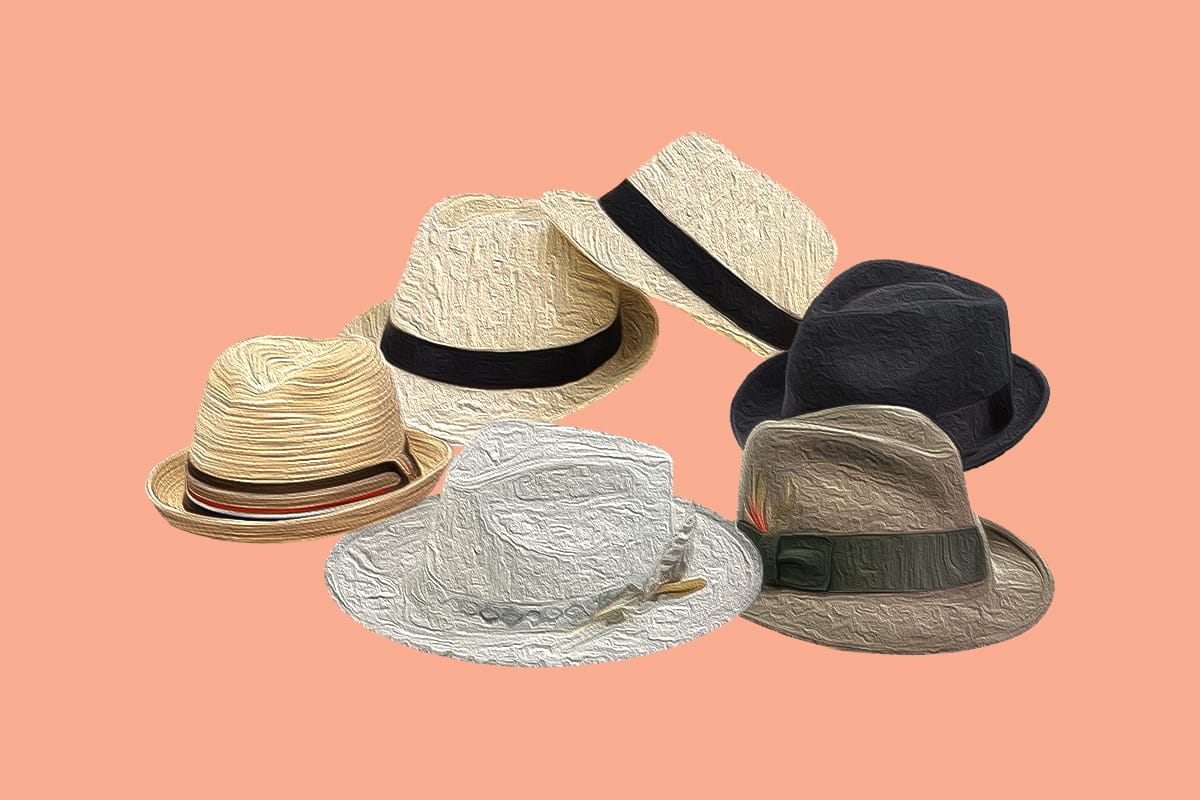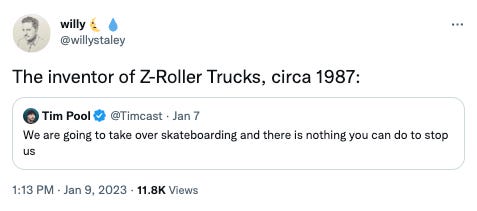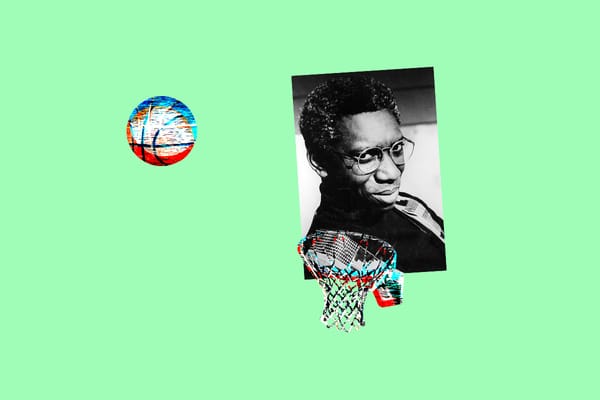A kid. A board. A dream.
Plus: Lee Yankou, signature moves, someone sponsor Walker Ryan, and more.

The definitive weekly ranking and analysis of all the skateboarding and other online things that I cannot stop consuming and how they make me feel, personally.

The great Canadian flying man
Rank: 1
Mood: 🦋
Canada is a big country, geographically speaking. According to unfurled maps and globes on shelves in cozy studies spun by curious hands, it’s the second largest on our lonesome, crowded planet. Most of its modest 39.2 million-person population lies on its coasts and near the southern border. This vastness means that if, like myself, you were a young skateboarder living on the Western-most side of the country through the late ‘90s and early-to-mid ‘00s, the only real insight you got into the skate scene in the East was through the pages of thin, perpetually dying and resurrecting Canadian skateboard magazines and the occasional shop, independent, or Canadian-centric brand video.
But sporadic photos, montage clips, or video parts don’t give the audience a complete and accurate picture of the skateboarder they showcase. When Lee Yankou began to show up in magazines, the seemingly fearless, high-popping daredevil who’s just as comfortable doing a frontside 360 over a park bench as he is finding a way to ride his board on the ceiling wasn’t yet on display. The first time I saw him, if my memory serves correct, was a “check out” in either Concrete or SBC Magazine featuring a young Yankou kickflip back boardsliding a gold handrail inside what looked to be a subway station while clad in his once infamous skin-tight red pants.
Those pants and that single trick were a red herring of sorts. It led me to believe that Yankou would be a handrail skateboarder in the vein of Billy Marks or the similarly colourful Garrett Hill. It wasn’t until he started to break through in the American market, highlighted by a standout part in Think’s Business As Usual, that we got to glimpse the full Lee Yankou experience.
Then, across a decade and the many video parts that followed, the Yankou we know now came into form. And in his recent “Raw Tapes” from Erick Valentick’s Vuja Dé, we get an especially entertaining and intimate picture of the skateboarder he has become, and likely, always has been, but just out of reach of my prying West coast eyes. “Holy fuck, I am getting smoked,” his charmingly Canadian twang rings out as he laments his struggles at a sketchy bump-to-bar-to-grind, the accent later accelerating as he declares local dog Spikey “a star.” It reaches a fever pitch as he talks himself into and through the steps required to land the hairball maneuvers only he could try and get away with.
It’s taken years and dramatic shifts in how the skateboarding media ecosystem works to see clearly across the few thousand or so kilometres between this country’s respective coasts, for the split hubs of the Canadian skateboarding scene to experience one another consistently and with greater clarity. Despite its many ills, social media is a portal in that way. But it’s still rarely a substitute for the real thing. A few summers ago, I visited Toronto and was lucky enough to watch Yankou fly around Dufferin Grove in person, flipping into wallrides and hurling himself over obstacles most would struggle to climb over. That flat image of the kid in unfortunate pants suddenly alive and leaping off the page.

Core signature moves
Rank: 2
Mood: 🤼♂️
All Elite Wrestling’s Darby Allin has long adopted the skateboard as a weapon in the ring. He’ll bomb drop onto an opponent, smack them upside the head with his board, or occasionally cover it with thumbtacks and rake it across his adversary’s body. But, if we’re being honest, those are gimmicks for the Zumiez crowd. If Allin ever decides that he wants to appeal to a more core audience, here are some suggestions for new, culturally specific signature moves.
Judo: Begins similar to the bomb drop but utilizes the judo grab to first kick an opponent with your front foot before landing on them with your board.
Dump Truck: Perform a dump truck off of the turnbuckle and into the back of your opponent, who should be on their knees and leaning forward into the ropes/turnbuckle, making their back into a helpful embankment to land into.
Stop Rock (Modifier): While riding down the entrance ramp to the ring, hit a rock, fly through the air, and perform a move of your choosing on an opponent.
Pet Cemetary: With your board’s chipped nose or tail, slice at an opponent’s ankles/Achilles.
Fleshie: When an opponent is stunned and lying on the canvas in the recovery position, wallie their stomach, which should leave them flat on their back and ready to pin.
Threadbare: Use the axle rethreaded from a skate tool to rethread an opponent’s nipple(s).

To roast or not to roast
Rank: N/A
Mood: N/A

It’s not always clear what the best course of action is when goaded to interact with the extended universe of bloviating, faux-aggrieved, far-right grifters that have made lucrative careers out of stoking the stupidest of culture war bullshit. On the one hand, if we want to stop hateful bigots like Tim Pool from creeping into skateboarding, it’s generally best to ignore them. Eventually, they’ll tire themselves out once people stop paying attention. But on the other hand, it is immensely satisfying to rip on assholes like him because it’s incredibly easy. Everything he says is so hollow, asinine, and repetitive it’s like he’s pressing random buttons on a Tim Pool soundboard. Because, in a way, he is. Pool and his ilk essentially A/B test their dogshit opinions all day to see what draws the most ire and create their own little news cycles out of it.
It’s all a part of the well-trodden path that these media also-rans and the immoral and untalented take in hopes of reaching some level of notoriety on the right. Their goal is to be as inflammatory as possible to draw eyeballs, build an audience, and eventually leverage it into a paying gig. Usually, a Patreon-supported podcast or some other wack punditry. It’s exactly what noted not-very-skilled skateboarder Taylor May Silverman did to kick off her campaign of whining after losing a contest to a trans woman. She made a petulant, transphobic Instagram post, tagged Pool, Ben Shapiro, and the like in it, and let the swirling vacuum of hate that followed take her into appearances on Piers Morgan and Pool’s shows. Since then, she’s been trying to make a half-baked career out of siccing targeted online hate campaigns on innocent people who are simply trying to skateboard and have fun.
Pool recently tweeted that “there is nothing you can do” to stop his odious gang of dipshits from taking over skateboarding (whatever that means), which is more of him just throwing garbage at the wall to see what sticks. The best way to deal with it is not to take the bait. However, when these clowns explicitly target members of our community, as Silverman does, it shouldn’t be ignored because there are real stakes. It’s a disgusting play used by her and a growing portion of figures on the right to demonize the trans community in a way they can use to fuel their imaginary grievances and, ultimately, their grifts. That’s when we should tell them to get fucked.

Brands, what are you waiting for?
Rank: 1
Mood: 💵💵💵
Professional skateboarder, author, and # skatetwitter’s most earnest poster, Walker Ryan, dropped a new video part on Monday. If you’ve followed Ryan’s career, the absurd technical prowess on display should not come as a surprise. From the switch impossible variations, the switch 360 flip into the NYC courthouse bank that makes an audible slap as it sucks to his feet, to an ender that is as twisted conceptually as it is physically. What is a surprise, however, is that Ryan appears to be without full-fledged shoe or board sponsors. This is doubly surprising because not only is he an amazing skateboarder, but from all accounts, he appears to be a great person to boot. I don’t want to speak for him, but I will make a clear, concise statement on behalf of the rest of us to the skateboarding industry at large:
Pay the man, goddamnit.

A kid. A board. A dream.
Rank: 1!!!!!
Mood: 🤤
Yes. Yesss. A Greg Lutzka documentary is precisely what we need—what I need. And it won’t simply be telling “the Greg Lutzka story,” but instead, “the story of Greg Lutzka.” That slight shift in syntax adds an extra layer of gravitas, mythos. And my god, the tagline: “A kid. A board. A dream.” Yesssss. Give us, me, the whole story. From the top. Illenium to Almost to Darkstar. Globe to K-Swiss to Osiris to DVS. Spill the juicy details behind the founding of Lutzka’s Garage, Lutzka’s self-described “ultimate online high-performance motorcycle shop” that apparently sells over 20,000 aftermarket motorcycle parts, including the DYNA Bassanixhaust Special Edition Greg Lutzka 2-Into-1 Stainless Exhaust. Its product description details the genesis for that collaboration. “Greg Lutzka is an absolute beast in the world of professional skateboarding, and he’s also [a] Dynaholic. As a fan of the Road Rage II, it was only natural that he team up with Bassani to design a signature series pipe.” I’m not sure what any of that means exactly, but I imagine the documentary features some compelling scenes of Lutzka sharing his struggle with Dynaholism.
Speaking of collabs, the director of One Way Ticket is a commercial and advertising photographer and director named Nick Amrhein. Amrhein’s website describes him as “Heavily tattooed, rides a Harley, skateboarder, and a type 1 diabetic,” which legitimately rules as far as bios go. He’s also made a number of mini-docs like Wolfpack: Desert Storm 30 Year Reunion and A Kid and His Camera: Story of Nick Amrhein, the latter you might correctly assume is about himself. It is astoundingly corny, self-serious, and makes it clear that Amrhein is the absolute perfect person to be making a Greg Lutzka documentary.
When the time comes, I will dutifully stand at the box office window, chin held high, and enunciate proud and clear to the cashier: “one ticket for One Way Ticket, please.”

Something to consider:
Good thing: More professional wrestling. Dan Brooks with a great profile of AEW’s Danhausen for The New York Times Magazine.
Another good thing: Al’s Skate House talked to all of your faves to find out the history of the laced-up hoodie.
An unfortunate thing: Stoned Wheat Thins may have been discontinued—a sad, sad development.
One more good thing to lift our spirits back up: The next step in the evolution of musical performance.
Until next week… remember, wherever you are, whether it’s raining or snowing or the sun is weighing down like a leaden blanket, somewhere in your neighbourhood, there’s a cat just waiting to be pet.






